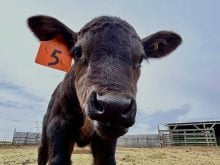Imagine as a livestock producer, whether of beef, dairy or hogs, and being able to get a daily read on animal weights just by checking your cellphone or tablet. You could track whether animals are maintaining their body condition, the average daily gain of a pen of steers or how many pigs have reached market weight.
Well, that’s not just wishful thinking. ClicRtechnologies, a Florida-based precision ag company, is now offering this reality (clicrweight.com). As creators of 3D-imaging technology supported by advanced vision software, they aim to replace traditional livestock weigh scales with artificial intelligence and machine learning.
Read Also

Harvest wraps up and fall work begins
At the Eppich famly ranch in western Saskatchewan, the fall harvest was successful with few breakdowns, cows and calves have been sorted and a new tractor has arrived
In the early 2000s, the idea blossomed in the mind of Joseph Spicola Sr., a former rancher, inventor and now CEO of ClicRtechnologies, when he became frustrated with the process of weighing cattle on his ranch.
“Getting cattle to the scales bothered me,” Spicola says. “Things would break down, need to be fixed, and often there was a shortage of cowboys to do the job. I knew there must be a better way, but I couldn’t find a solution. Then, I had a bit of a vision and thought maybe I could use pictures instead.”
Setup and possibilities
Spicola and his team devised three weight solutions comprised of 3D-image cameras, RFID readers, computer software and an algorithm created with artificial intelligence and machine learning. Real-time weights are delivered through a cloud-based web server to a smartphone, tablet or computer.
Scaleless weighing solutions are available for cattle and hogs, while in southern states they can even be used for farmed alligators. That same technology will soon be available in Canada.
Bovine and swine options feature a 3D-image camera and computer installed at a water source. Early in their life, each animal is outfitted with an RFID ear tag. Each time they drink, an RFID reader identifies individuals from ear tags while the camera unobtrusively captures between 100 and 200 images of each animal. With up to 500 pictures taken during a 24-hour cycle, an algorithm calculates a weight and uploads it to the cloud where it can be accessed along with an inventory, average daily gains (ADGs) and other performance markers.
From pictures to data
ClicRtechnologies is changing the way producers make decisions, helping them prioritize knowledge and data in their management systems, says global sales manager Sergio Monge. They accomplish this by providing a daily calculated weight deemed to be 96 per cent accurate.
“Weights, average daily gains and photos are all in the palm of your hand, 24/7, 365 days a year. Plus, with continuous improvement, our technology has been trained to not only weigh an animal but to recognize distinct breeds by interpreting a detailed user-generated profile,” he says.

The technology counts the times they drink, tracks gain and recognizes a pre-programmed ‘sweet spot’ for finishing. When the desired target is reached, the system activates equipment that marks the animal with paint. It can even be manipulated to deliver exact amounts of topically applied parasitic treatment based on individual weights.”
The company says the hardware is tested and protected against condensation and cold temperatures, as the internal components create their own heat, keeping them operating seamlessly in all climates. The algorithm coding is also tuned to understand behaviour in response to the environment, helping to maintain its accuracy.
Monge says producers too often today need to make management decisions on limited information. But, with ClicR, they have real-time data. Feed rations can be altered, livestock not performing well can be removed from a pen, or finished animals can be easily identified and sorted for market.
“With real-time key performance indicators of cattle or swine, savings are realized in reduced feed waste, by preventing marketing of over- or undersized carcasses, and by recognizing sickness in those not drinking as they should,” Monge says.
Coming to Canada
ClicRtechnologies is expanding its sales and service into Canada and hopes to soon begin placing the technology in Canadian operations. It has begun a working association with a prominent Canadian swine genetics company to improve breeding management practices and add depth and robustness to the algorithm.
More measurements are coming. Soon, the company will add a body conditioning score application for dairy and cow-calf operators, along with lameness prediction abilities for cattle and hogs.
“We want to change the status quo,” Monge says. “We often hear, ‘my dad or grandad did it this way.’ We tell them there’s nothing wrong with that, but now there’s a newer, easier, faster and more accurate way.”















